Poor drainage: Nakuru's most notorious flooding zones
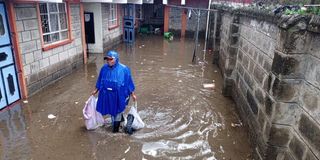
Caroline Murige collects garbage brought in by storm water at her apartments in Ngala estate on September 2, 2024.
For the better part of this year, Nakuru County has experienced heavy rainfall.
Even though it has come with its fair share of blessings especially to the farmers, the rain has also left us exposed to the wrath of mother nature.
From emerging fissures in various parts of the county, to the horrific incident in Maai Mahiu that claimed the lives of tens of people, leaving many more displaced.
On September 3, the horrific death of Sammy Kipkemei Tarus hit news headlines, revealing details on how the 52-year-old catechist was swept by floods as he tried to navigate the raging waters at the Eveready Roundabout on his way home to Kaptembwa.

The late Sammy Kipkemei Tarus.
It is known that Nakuru city assumes a slanting position and therefore when it rains, all the water heads towards Lake Nakuru which is the largest water body in the County.
Areas around Kaptembwa, Pondamali and Kingdom Seekers are along the path of water as it heads to Lake Nakuru and therefore when it rains, businesses and residential houses on this route suffer the devastating effects of the storm water.
As we approach Pondamali after heavy rainfall, we notice the drainages which in turns spill water to the road.
Near the market, a path, that is commonly used by pedestrians has developed into a small river rendering it impassable.
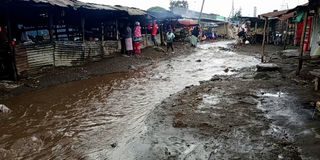
A market in Pondamali that was flooded after a heavy downpour on April 13, 2024.
It is along the path of this ferocious waters that we spot Jaqueline Mong’are, a fish vendor.
“Whenever it rains, the storm water finds its way into my business, blocking the entrance to my kibanda. Sometimes, the water comes with so much force. I am scared it can carry me away,” she says.
The fishmonger says the fish business is her sole source of income, therefore making it difficult for her to move to another stall.
In another incident that occurred on September 2, a heavy down pour that was witnessed for a better part of the afternoon found its way into the houses of residents in Ngala Estate.
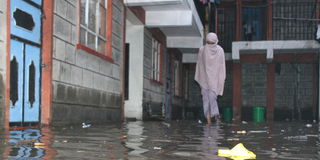
A residents in Ngala estate navigates through storm water after their apartment was flooded on September 2, 2024.
Upon arrival in one on of the apartments in this area, we were met with storm water that had flooded one of the apartments in the estate, making the entire ground floor inaccessible.
Here, we met Caroline Murige, the apartment owner, in her rain coat and gumboot navigating through the water trying to clear the waste materials that were carried by the storm water.
The stench coming from the water was sickening. One could spot used diapers, condoms, vegetable refuse among other items floating in the water.
“I built these apartments over 15 years ago and I have always complained about the poor drainage system since most of the water that comes from the city centre has always found its way into our houses. Additionally, hii maji inakuja na uchafu yote kutoka town, which makes it worse as it increases the risk of water borne diseases,” she says.
The land lady laments how she would have to incur an extra cost paying for a pump machine so that she can remove the stagnant water from her apartment.
In Gilani Estate the situation is the same as Peter Kimani sadly explains.
“I live on the ground floor of my apartment and whenever I am at work and it rains, I am always sure without a doubt that my house will be flooded. Saa zingine nafungua mlango yangu napata maji imejaa na maviatu zimefloat kwa nyumba,” he says.
Mtaa Wangu moved away from the estates and made its way to the city centre, where the challenges faced in the estates seems to emanate from.
At the Gateiguru Railway crossing, we are met with a large mass of water in the underpass, that has caused a traffic snarl up as vehicles slowly navigate the flooded road.
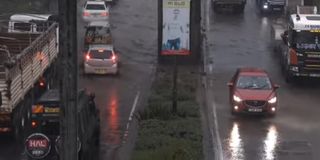
Vehicles struggle to navigate the floods at the underpass near Gigma in Nakuru city.
Robert AKA Kizoo narrates how he always fears driving on that road into town whenever it rains.
“I fear using the road because as you try to manoeuvre your way through the mass of water, the water may find its way into your engine and destroy it. Also, that water comes carrying sharp objects which may puncture your tire and set you back a lot financially,” he says.
The artist says that he has had to repair his car severally due to this fact.
Another worrying section is club lane, as Peter Odhiambo, a trader on this stretch, narrates.
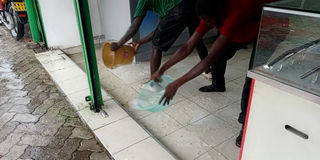
Business persons removing water from their shops in the city centre, after storm water got into their shop on April 7, 2024.
“There have been numerous efforts put into trying to solve the drainage problem here at Club Lane but nothing sustainable. Every time it starts to rain, the place floods, leaving this part of the city looking really dirty since the water comes carrying garbage and dumps it all here,” he laments.
From the city centre all through to the various estates in Nakuru, the matters pertaining to the drainage system seem to be a nuisance.
Maybe itabidi kila mtu amenunua boat yake.
